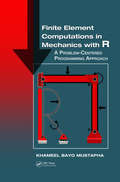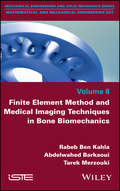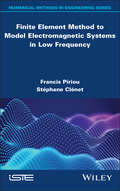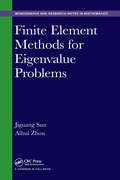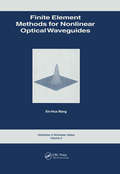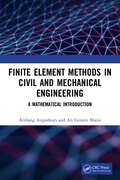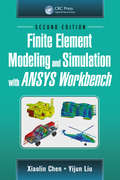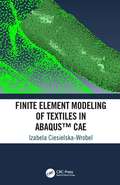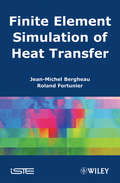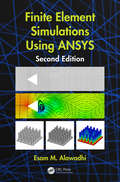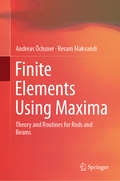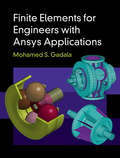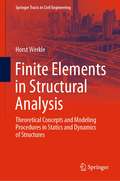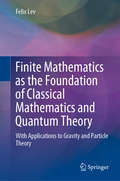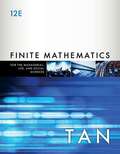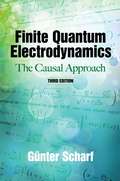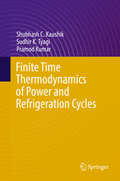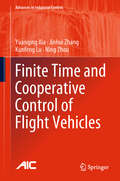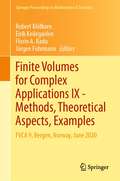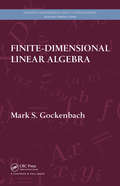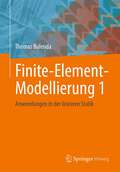- Table View
- List View
Finite Element Computations in Mechanics with R: A Problem-Centered Programming Approach
by Khameel Bayo MustaphaFinite Element Computations in Mechanics with R: A Problem-Centred Programming Approach provides introductory coverage of the finite element method (FEM) with the R programming language, emphasizing links between theory and implementation of FEM for problems in engineering mechanics. Useful for students, practicing engineers, and researchers, the text presents the R programming as a convenient easy-to-learn tool for analyzing models of mechanical systems, with finite element routines for structural, thermal, and dynamic analyses of mechanical systems, and also visualization of the results. Full-color graphics are used throughout the text.
Finite Element Method and Medical Imaging Techniques in Bone Biomechanics
by Abdelwahed Barkaoui Rabeb Ben Kahla Tarek MerzoukiDigital models based on data from medical images have recently become widespread in the field of biomechanics. This book summarizes medical imaging techniques and processing procedures, both of which are necessary for creating bone models with finite element methods. Chapter 1 introduces the main principles and the application of the most commonly used medical imaging techniques. Chapter 2 describes the major methods and steps of medical image analysis and processing. Chapter 3 presents a brief review of recent studies on reconstructed finite element bone models, based on medical images. Finally, Chapter 4 reveals the digital results obtained for the main bone sites that have been targeted by finite element modeling in recent years.
Finite Element Method to Model Electromagnetic Systems in Low Frequency
by Francis Piriou Stéphane ClénetNumerical modeling now plays a central role in the design and study of electromagnetic systems. In the field of devices operating in low frequency, it is the finite element method that has come to the fore in recent decades. Today, it is widely used by engineers and researchers in industry, as well as in research centers. This book describes in detail all the steps required to discretize Maxwell’s equations using the finite element method. This involves progressing from the basic equations in the continuous domain to equations in the discrete domain that are solved by a computer. This approach is carried out with a constant focus on maintaining a link between physics, i.e. the properties of electromagnetic fields, and numerical analysis. Numerous academic examples, which are used throughout the various stages of model construction, help to clarify the developments.
Finite Element Method: Applications in Solids, Structures, and Heat Transfer (Mechanical Engineering)
by Michael R. GoszThe finite element method (FEM) is the dominant tool for numerical analysis in engineering, yet many engineers apply it without fully understanding all the principles. Learning the method can be challenging, but Mike Gosz has condensed the basic mathematics, concepts, and applications into a simple and easy-to-understand reference.Finite Element Method: Applications in Solids, Structures, and Heat Transfer navigates through linear, linear dynamic, and nonlinear finite elements with an emphasis on building confidence and familiarity with the method, not just the procedures. This book demystifies the assumptions made, the boundary conditions chosen, and whether or not proper failure criteria are used. It reviews the basic math underlying FEM, including matrix algebra, the Taylor series expansion and divergence theorem, vectors, tensors, and mechanics of continuous media.The author discusses applications to problems in solid mechanics, the steady-state heat equation, continuum and structural finite elements, linear transient analysis, small-strain plasticity, and geometrically nonlinear problems. He illustrates the material with 10 case studies, which define the problem, consider appropriate solution strategies, and warn against common pitfalls. Additionally, 35 interactive virtual reality modeling language files are available for download from the CRC Web site.For anyone first studying FEM or for those who simply wish to deepen their understanding, Finite Element Method: Applications in Solids, Structures, and Heat Transfer is the perfect resource.
Finite Element Methods for Eigenvalue Problems (Chapman & Hall/CRC Monographs and Research Notes in Mathematics)
by Jiguang Sun Aihui ZhouThis book covers finite element methods for several typical eigenvalues that arise from science and engineering. Both theory and implementation are covered in depth at the graduate level. The background for typical eigenvalue problems is included along with functional analysis tools, finite element discretization methods, convergence analysis, techniques for matrix evaluation problems, and computer implementation. The book also presents new methods, such as the discontinuous Galerkin method, and new problems, such as the transmission eigenvalue problem.
Finite Element Methods for Nonlinear Optical Waveguides
by Xin-Hua WangThis book provides researchers at the forefront of nonlinear optical technologies with robust procedures and software for the systematic investigation of the fundamental phenomena in nonlinear optical waveguide structures. A full vectorial electromagnetic formulation is adopted and the conditions under which simplification to a scalar formulation is possible are clearly indicated. The need to model the dielectric saturation properly is identified, and improved algorithms are presented for obtaining the complete power dispersion curve of structures exhibiting bistability. As the stability analysis of nonlinear modes is crucial to the development of nonlinear model methods, an effective procedure to investigate the propagation of the scalar nonlinear waves in 3D is another important feature of the book. All of the procedures described, as well as an automatic mesh generator for the finite element method, are incorporated into a software package which is included with this book.
Finite Element Methods in Civil and Mechanical Engineering: A Mathematical Introduction
by Arzhang Angoshtari Ali Gerami MatinThe finite element method is widely employed for numerical simulations in engineering and science due to its accuracy and efficiency. This concise introduction to the mathematical theory of the finite element method presents a selection of applications in civil and mechanical engineering including beams, elastic membranes, the wave equation, heat transfer, seepage in embankment, soil consolidation, incompressible fluids, and linear elasticity. Jupyter notebooks containing all Python programs of each chapter can be downloaded from the book's companion website. Arzhang Angoshtari is an assistant professor and Ali Gerami Matin is a graduate student, both in the department of Civil and Environmental Engineering at the George Washington University, USA. Their research interests cover theoretical and computational mechanics and finite element methods.
Finite Element Modeling and Simulation with ANSYS Workbench, Second Edition
by Yijun Liu Xiaolin ChenFinite Element Modeling and Simulation with ANSYS Workbench 18, Second Edition, combines finite element theory with real-world practice. Providing an introduction to finite element modeling and analysis for those with no prior experience, and written by authors with a combined experience of 30 years teaching the subject, this text presents FEM formulations integrated with relevant hands-on instructions for using ANSYS Workbench 18. Incorporating the basic theories of FEA, simulation case studies, and the use of ANSYS Workbench in the modeling of engineering problems, the book also establishes the finite element method as a powerful numerical tool in engineering design and analysis. Features Uses ANSYS Workbench™ 18, which integrates the ANSYS SpaceClaim Direct Modeler™ into common simulation workflows for ease of use and rapid geometry manipulation, as the FEA environment, with full-color screen shots and diagrams. Covers fundamental concepts and practical knowledge of finite element modeling and simulation, with full-color graphics throughout. Contains numerous simulation case studies, demonstrated in a step-by-step fashion. Includes web-based simulation files for ANSYS Workbench 18 examples. Provides analyses of trusses, beams, frames, plane stress and strain problems, plates and shells, 3-D design components, and assembly structures, as well as analyses of thermal and fluid problems.
Finite Element Modeling of Textiles in Abaqus™ CAE
by Izabela Ciesielska-WrobelThe aim of the book is to provide engineers with a practical guide to Finite Element Modelling (FEM) in Abaqus CAE software. The guide is in the form of step-by-step procedures concerning yarns, woven fabric and knitted fabrics modelling, as well as their contact with skin so that the simulation of haptic perception between textiles and skin can be
Finite Element Simulation of Heat Transfer
by Jean-Michel Bergheau Roland FortunierThis book introduces the finite element method applied to the resolution of industrial heat transfer problems. Starting from steady conduction, the method is gradually extended to transient regimes, to traditional non-linearities, and to convective phenomena. Coupled problems involving heat transfer are then presented. Three types of couplings are discussed: coupling through boundary conditions (such as radiative heat transfer in cavities), addition of state variables (such as metallurgical phase change), and coupling through partial differential equations (such as electrical phenomena). A review of the various thermal phenomena is drawn up, which an engineer can simulate. The methods presented will enable the reader to achieve optimal use from finite element software and also to develop new applications.
Finite Element Simulations Using ANSYS
by Esam M. AlawadhiUses a Step-By-Step Technique Directed with Guided Problems and Relevant Screen Shots Simulation use is on the rise, and more practicing professionals are depending on the reliability of software to help them tackle real-world mechanical engineering problems. Finite Element Simulations Using ANSYS, Second Edition offers a basic understanding of the
Finite Elements Methods in Mechanics
by M. Reza EslamiThis book covers all basic areas of mechanical engineering, such as fluid mechanics, heat conduction, beams and elasticity with detailed derivations for the mass, stiffness and force matrices. It is especially designed to give physical feeling to the reader for finite element approximation by the introduction of finite elements to the elevation of elastic membrane. A detailed treatment of computer methods with numerical examples are provided. In the fluid mechanics chapter, the conventional and vorticity transport formulations for viscous incompressible fluid flow with discussion on the method of solution are presented. The variational and Galerkin formulations of the heat conduction, beams and elasticity problems are also discussed in detail. Three computer codes are provided to solve the elastic membrane problem. One of them solves the Poisson's equation. The second computer program handles the two dimensional elasticity problems and the third one presents the three dimensional transient heat conduction problems. The programs are written in C++ environment.
Finite Elements Using Maxima: Theory and Routines for Rods and Beams
by Andreas Öchsner Resam MakvandiThis book provides a study aid on the finite element method. Based on the free computer algebra system “Maxima”, it presents routines to symbolically or numerically solve problems in the context of plane truss and frame structures. This allows readers to not only check classical “hand calculations” but also understand the computer implementation of the method. The mechanical theories focus on the classical one-dimensional structural elements, i.e. bars, Euler–Bernoulli and Timoshenko beams as well as their combination to generalized beam elements. Focusing on one-dimensional elements reduces the complexity of the mathematical framework and the resulting matrix equations can still be displayed with all components, and not only in a symbolic representation. The use of a computer algebra system and the incorporated functions, e.g. for equation solving, highlights the methodology of the finite element method rather than standard procedures.The book is based on the Springer Brief “Finite Elements for Truss and Frame Structures” (978-3-319-94940-6) by the same authors.
Finite Elements for Engineers with ANSYS Applications
by Mohamed GadalaThe finite element method (FEM) is indispensable in modeling and simulation in various engineering and physical systems, including structural analysis, stress, strain, fluid mechanics, heat transfer, dynamics, eigenproblems, design optimization, sound propagation, electromagnetics, and coupled field problems. This textbook integrates basic theory with real-life, design-oriented problems using ANSYS, the most commonly used computational software in the field. For students as well as practicing engineers and designers, each chapter is highly illustrated and presented in a step-by-step manner. Fundamental concepts are presented in detail with reference to easy to understand worked examples that clearly introduce the method before progressing to more advanced content. Included are step-by-step solutions for project type problems using modelling software, special chapters for modelling and the use of ANSYS and Workbench programs, and extensive sets of problems and projects round out each chapter.
Finite Elements in Structural Analysis: Theoretical Concepts and Modeling Procedures in Statics and Dynamics of Structures (Springer Tracts in Civil Engineering)
by Horst WerkleThe book introduces the basic concepts of the finite element method in the static and dynamic analysis of beam, plate, shell and solid structures, discussing how the method works, the characteristics of a finite element approximation and how to avoid the pitfalls of finite element modeling. Presenting the finite element theory as simply as possible, the book allows readers to gain the knowledge required when applying powerful FEA software tools. Further, it describes modeling procedures, especially for reinforced concrete structures, as well as structural dynamics methods, with a particular focus on the seismic analysis of buildings, and explores the modeling of dynamic systems. Featuring numerous illustrative examples, the book allows readers to easily grasp the fundamentals of the finite element theory and to apply the finite element method proficiently.
Finite Mathematics as the Foundation of Classical Mathematics and Quantum Theory: With Applications to Gravity and Particle Theory
by Felix LevThis book delves into finite mathematics and its application in physics, particularly quantum theory. It is shown that quantum theory based on finite mathematics is more general than standard quantum theory, whilst finite mathematics is itself more general than standard mathematics.As a consequence, the mathematics describing nature at the most fundamental level involves only a finite number of numbers while the notions of limit, infinite/infinitesimal and continuity are needed only in calculations that describe nature approximately. It is also shown that the concepts of particle and antiparticle are likewise approximate notions, valid only in special situations, and that the electric charge and baryon- and lepton quantum numbers can be only approximately conserved.
Finite Mathematics for Business, Economics, Life Sciences, and Social Sciences (Thirteenth Edition)
by Raymond A. Barnett Michael R. Ziegler Karl E. ByleenLearn about the math that will help you in many careers and academic disciplines.
Finite Mathematics: For The Managerial, Life, And Social Sciences
by Soo T. TanFINITE MATHEMATICS FOR THE MANAGERIAL, LIFE, AND SOCIAL SCIENCES, Twelfth Edition, is a clear, easy-to-follow text that balances contemporary mathematics applications and the latest technology to help give you the key problem-solving skills you need for your life and career in the 21st century. Real-world applications put math concepts in context and cover topics including social media accounts, corporate fraud, criminal justice, cyber privacy, starting a new job, gas prices, smartphone ownership, mobile ad revenues, and more.
Finite Quantum Electrodynamics: The Causal Approach, Third Edition (Dover Books on Physics)
by Gunter ScharfIn this classic text for advanced undergraduates and graduate students of physics, author Günter Scharf carefully analyzes the role of causality in quantum electrodynamics. His approach offers full proofs and detailed calculations of scattering processes in a mathematically rigorous manner. This third edition contains Scharf's revisions and corrections plus a brief new Epilogue on gauge invariance of quantum electrodynamics to all orders. The book begins with Dirac's theory, followed by the quantum theory of free fields and causal perturbation theory, a powerful method that avoids ultraviolet divergences and solves the infrared problem by means of the adiabatic limit. Successive chapters explore properties of the S-matrix -- such as renormalizability, gauge invariance, and unitarity -- the renormalization group, and interactive fields. Additional topics include electromagnetic couplings and the extension of the methods to non-abelian gauge theories. Each chapter is supplemented with problems, and four appendixes conclude the text.
Finite Sample Analysis in Quantum Estimation
by Takanori SugiyamaIn this thesis, the author explains the background of problems in quantum estimation, the necessary conditions required for estimation precision benchmarks that are applicable and meaningful for evaluating data in quantum information experiments, and provides examples of such benchmarks. The author develops mathematical methods in quantum estimation theory and analyzes the benchmarks in tests of Bell-type correlation and quantum tomography with those methods. Above all, a set of explicit formulae for evaluating the estimation precision in quantum tomography with finite data sets is derived, in contrast to the standard quantum estimation theory, which can deal only with infinite samples. This is the first result directly applicable to the evaluation of estimation errors in quantum tomography experiments, allowing experimentalists to guarantee estimation precision and verify quantitatively that their preparation is reliable.
Finite Time Thermodynamics of Power and Refrigeration Cycles
by Pramod Kumar Shubhash C. Kaushik Sudhir K. TyagiThis book addresses the concept and applications of Finite Time Thermodynamics to various thermal energy conversion systems including heat engines, heat pumps, and refrigeration and air-conditioning systems. The book is the first of its kind, presenting detailed analytical formulations for the design and optimisation of various power producing and cooling cycles including but not limited to: * Vapour power cycles* Gas power cycles* Vapour compression cycles* Vapour absorption cycles* Rankine cycle coupled refrigeration systems Further, the book addresses the thermoeconomic analysis for the optimisation of thermal cycles, an important field of study in the present age and which is characterised by multi-objective optimization regarding energy, ecology, the environment and economics. Lastly, the book provides the readers with key techniques associated with Finite Time Thermodynamics, allowing them to understand the relevance of irreversibilities associated with real processes and the scientific reasons for deviations from ideal performance. The book is aimed at a broad readership, and offers a valuable reference book for graduate students, scholars and professionals working in the areas of thermal science and engineering.
Finite Time and Cooperative Control of Flight Vehicles (Advances in Industrial Control)
by Yuanqing Xia Jinhui Zhang Kunfeng Lu Ning ZhouThis book focuses on the finite-time control of attitude stabilization, attitude tracking for individual spacecraft, and finite-time control of attitude synchronization. It discusses formation reconfiguration for multiple spacecraft in complex networks, and provides a new fast nonsingular terminal sliding mode surface (FNTSMS). Further, it presents newly designed controllers and several control laws to enhance the performance of spacecraft systems and meet related demands, such as strong disturbance rejection and high-precision control. As such, the book establishes a fundamental framework for these topics, while also highlighting the importance of integrated analysis. It is a useful resource for all researchers and students who are interested in this field, as well as engineers whose work involves designing flight vehicles.
Finite Volumes for Complex Applications IX - Methods, Theoretical Aspects, Examples: FVCA 9, Bergen, Norway, June 2020 (Springer Proceedings in Mathematics & Statistics #323)
by Jürgen Fuhrmann Robert Klöfkorn Eirik Keilegavlen Florin A. RaduThe proceedings of the 9th conference on "Finite Volumes for Complex Applications" (Bergen, June 2020) are structured in two volumes. The first volume collects the focused invited papers, as well as the reviewed contributions from internationally leading researchers in the field of analysis of finite volume and related methods. Topics covered include convergence and stability analysis, as well as investigations of these methods from the point of view of compatibility with physical principles. Altogether, a rather comprehensive overview is given on the state of the art in the field. The properties of the methods considered in the conference give them distinguished advantages for a number of applications. These include fluid dynamics, magnetohydrodynamics, structural analysis, nuclear physics, semiconductor theory, carbon capture utilization and storage, geothermal energy and further topics. The second volume covers reviewed contributions reporting successful applications of finite volume and related methods in these fields. The finite volume method in its various forms is a space discretization technique for partial differential equations based on the fundamental physical principle of conservation. Many finite volume methods preserve further qualitative or asymptotic properties, including maximum principles, dissipativity, monotone decay of free energy, and asymptotic stability, making the finite volume methods compatible discretization methods, which preserve qualitative properties of continuous problems at the discrete level. This structural approach to the discretization of partial differential equations becomes particularly important for multiphysics and multiscale applications. The book is a valuable resource for researchers, PhD and master’s level students in numerical analysis, scientific computing and related fields such as partial differential equations, as well as engineers working in numerical modeling and simulations.
Finite-Dimensional Linear Algebra (Discrete Mathematics and Its Applications)
by Mark S. GockenbachThis text provides a solid foundation for the study of advanced mathematics and covers many interesting applications of linear algebra, which show how linear algebra is essential in such diverse areas as combinatorics, differential equations, optimization, and approximation. The book discusses important concepts and methods from numerical linear algebra and contains a range of exercises in each section, including some that can be solved using a computer package such as MATLAB. It also incorporates mini-projects that encourage students to develop topics not covered in the text. A forthcoming solutions manual is available for qualifying instructors.
Finite-Element-Modellierung 1: Anwendungen in der linearen Statik
by Thomas BulendaEs gibt eine Vielzahl von „Wie-erstelle-ich-ein Finite-Element-Programm?“-Lehrbüchern, aber nur recht wenige Veröffentlichungen zur Frage „Wie wende ich ein Finite-Element-Programm an?“. Dieses Buch legt den Schwerpunkt auf die zweite Fragestellung. Es basiert auf den Vorlesungen zur Anwendung der Finite-Element-Methode, die der Autor seit 1998 an der OTH Regensburg hält. Deren Inhalte kommen aus seiner Tätigkeit als Prüfingenieur für Baustatik in einem großen Münchener Ingenieurbüro. Behandelt werden sowohl Fragestellungen, mit denen sich jeder Ingenieur konfrontiert sieht, wenn er Berechnungen mit einem Finite-Element-Programm erstellen will, als auch Problempunkte, die im Büro des Autors im Zuge einer Projektbearbeitung auftraten und auf den ersten Blick gar nicht so klar waren. In Teil 1 des zweibändigen Werks werden Themen aus der linearen Statik behandelt.
